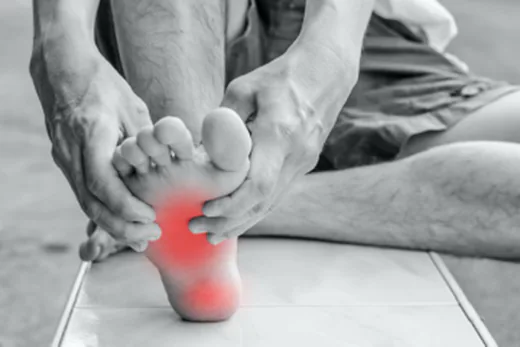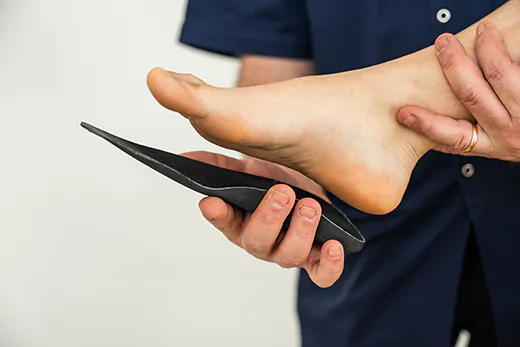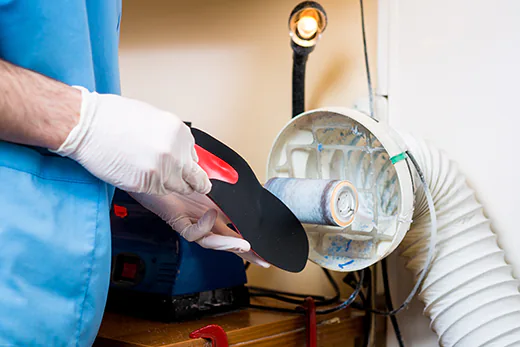
Is There a Difference Between Off-The-Shelf and Custom Plaster Cast Orthotics?
The Plaster cast technique is the only method that is universally accepted by all insurance companies and it is considered the gold standard when creating an orthotic device. This made it more popular than the impression foam and slipper socks method. Read on to learn some significant benefits of this form of custom foot orthotics.
What Are Custom Foot Orthotics?
Foot orthoses or “orthotics” are specially prescribed inserts that are designed to be placed inside of your shoes. Their function is to correct some kind of misalignment in the foot. Orthotics are generally constructed from a semi-rigid or rigid plastic, carbon fiber or other composite material. The unique properties of these materials allow them to flex repeatedly while still maintaining their original shape. In fact, these materials are so durable they generally will not crack or break even with excessive use.
Orthotics are designed to reduce or control abnormal motion of the foot. Typically, foot-related pain will occur when the foot is attempting to compensate for an abnormal alignment of the foot or lower leg. These compensations will manifest themselves into a variety of ailments including: plantar fasciitis, metatarsalgia, sesamoiditis, hammertoes, neuromas, shin splints (anterior tibial tendinitis), arch pain, sciatica, patella fermoral syndrome, corns, calluses, early arthritic changes and so forth. A misaligned foot can cause an endless array of secondary problems.
When a chiropodist decides that an orthotic is the best course of treatment for you, he or she considers several factors. The specific foot condition you have is probably the most important. However, the type of footwear you wear, the activities you do, and your occupation can also all factor into the effectiveness of your foot orthotics.

In addition, the chiropodist will examine your joint ranges of motion, your gait, your foot muscle strength and your general standing position. All of these factors play an integral role in determining the best type of orthotic.
Is There a Difference Between Off-The-Shelf and Custom Plaster Cast Orthotics?
Most Definitely! Grocery stores and drugstores often sell Off-the-shelf (OTS) devices and insoles. These can range from full-length memory foam insoles to small gel heel cups. They come in a variety of shapes, sizes and colours and usually have a “scientific”-looking brochure enclosed with them. Do not be fooled by fancy marketing. OTC insoles are generic and are only marginally better than the original insoles that came with your shoes. OTS insoles are NOT the same as an orthotic. Orthotics are made for your specific foot. They are designed to realign and/or accommodate your foot deformity and no one else's.
Making the Plaster Cast and Mold
To make a plaster cast, a chiropodist will first ask a patient to lie down or sit. They will then position the foot into a neutral position. It is important that the patient does not flex or contract their foot muscles while the moulds are being made, otherwise the cast will be inaccurate.
The chiropodist will then take wet plaster strips and wrap them around the patient's foot. It will take approximately 10 minutes for the plaster to harden sufficiently to allow it to be removed. During this time, the chiropodist will make sure that the patient doesn't move their foot to ensure that the correct alignment of the foot is maintained.
Once the casts have completely hardened, they will be couriered to a lab. Medical Foot Solutions uses Paris Orthotics Lab. Once at the lab, the technicians will digitally scan the plaster moulds. The data generated from the scanned moulds is then sent to a CNC milling machine which grinds out a positive representation of the patient’s foot. This “positive” mould will form the basis of your orthotics. You can get a great view of this process by visiting the Paris Orthotics website.
Making the Orthotics
Once the positive impression has been generated, the orthotic making process can begin. The worker will look at the information and instructions the chiropodist has supplied.
He or she will vacuum press the plaster mould against a heated material. The material chosen depends on the specific needs of the patient. While the worker presses down on it, it will take the form of the plaster cast.
 Benefits of a Plaster Cast
Benefits of a Plaster Cast
It's Accurate
A plaster cast can record the precise details of a patient's foot far more accurately than other methods. This can make it the best choice to assist in the treatment of certain ailments. Ones such as foot control issues or severe deformities require the capture of every subtle detail.
The Foot Is Aligned
One downside of the impression foam method is that the foot must press down into the foam. This can cause some inaccuracies depending on how the foot flexes when it presses into the foam.
A plaster casting, however, is made with the foot in a flat position. This way, the forefoot and heel are aligned.
Chiropodists Can Mark It
The outer surface of a plaster cast can hold a pencil or marker mark well. This way, the chiropodist can indicate which areas of the foot need relief. Lab workers can find this information useful as they make the foot orthotic.
Downsides of a Plaster Cast
Unfortunately, there are still some downsides that chiropodists need to consider when they're making a plaster cast. However, there are often easy ways to overcome them.
Time Consuming
The creation of a plaster cast takes more time than the creation of other mould types. If a patient doesn't have a lot of control of their foot, it might be difficult for them to hold still.
Medical Foot Solutions Can Provide You with the Treatment You Need
At Medical Foot Solutions we feel that the plaster cast technique is the best method for making your orthotics. Foot specialists and the insurance industry also agree that the plaster method is the best choice when making orthotics.
However, orthotics are not the only option when it comes to treating foot pain and misalignment.
Medical Foot Solution's HyProCure procedure may be that method. If you have flat or misaligned feet, consider working with us.
We have two out of nine chiropodists across Canada that are certified for the procedure. Jonathan and Ruth have also performed the procedure more than their peers.
Book an appointment today!

